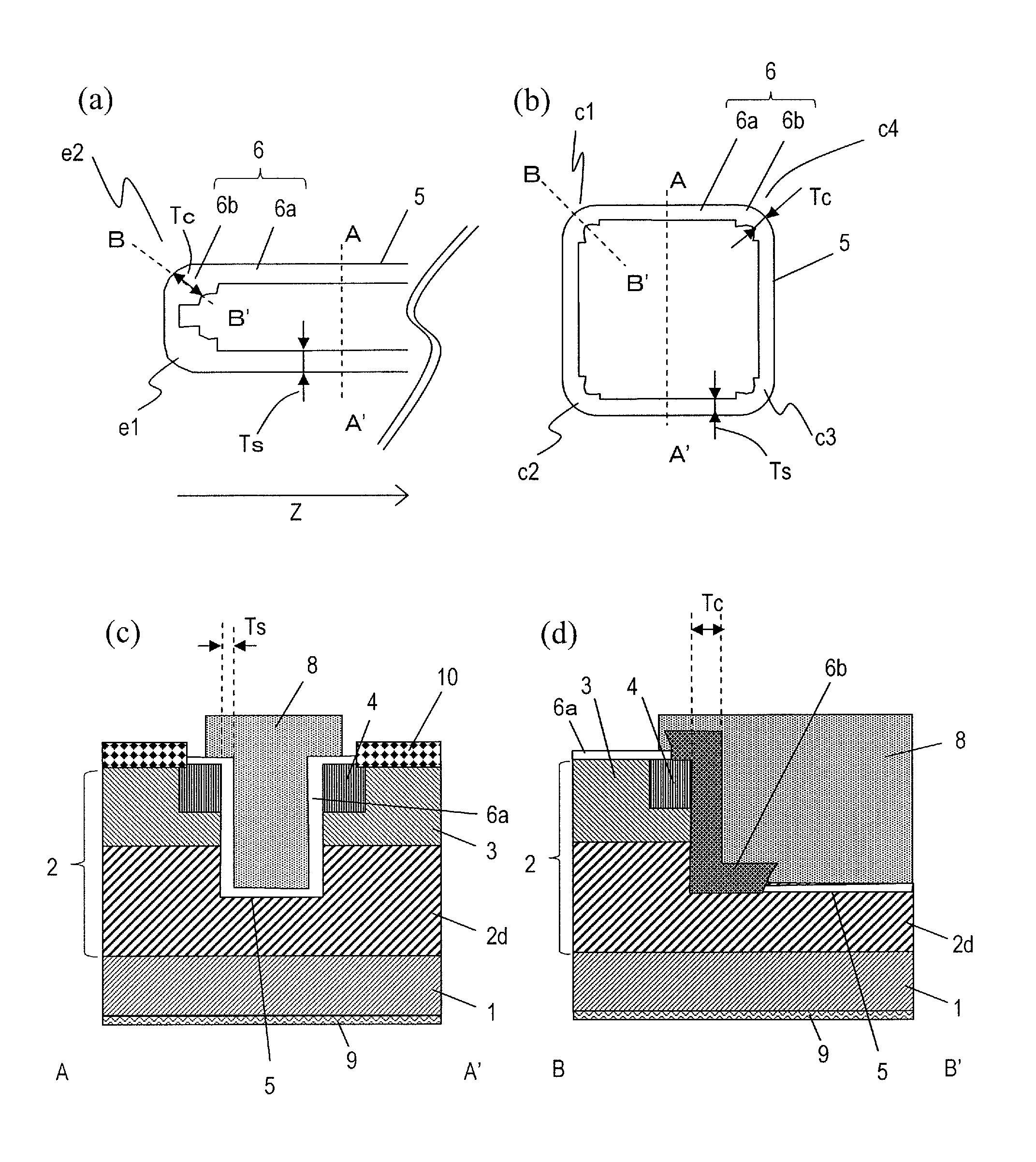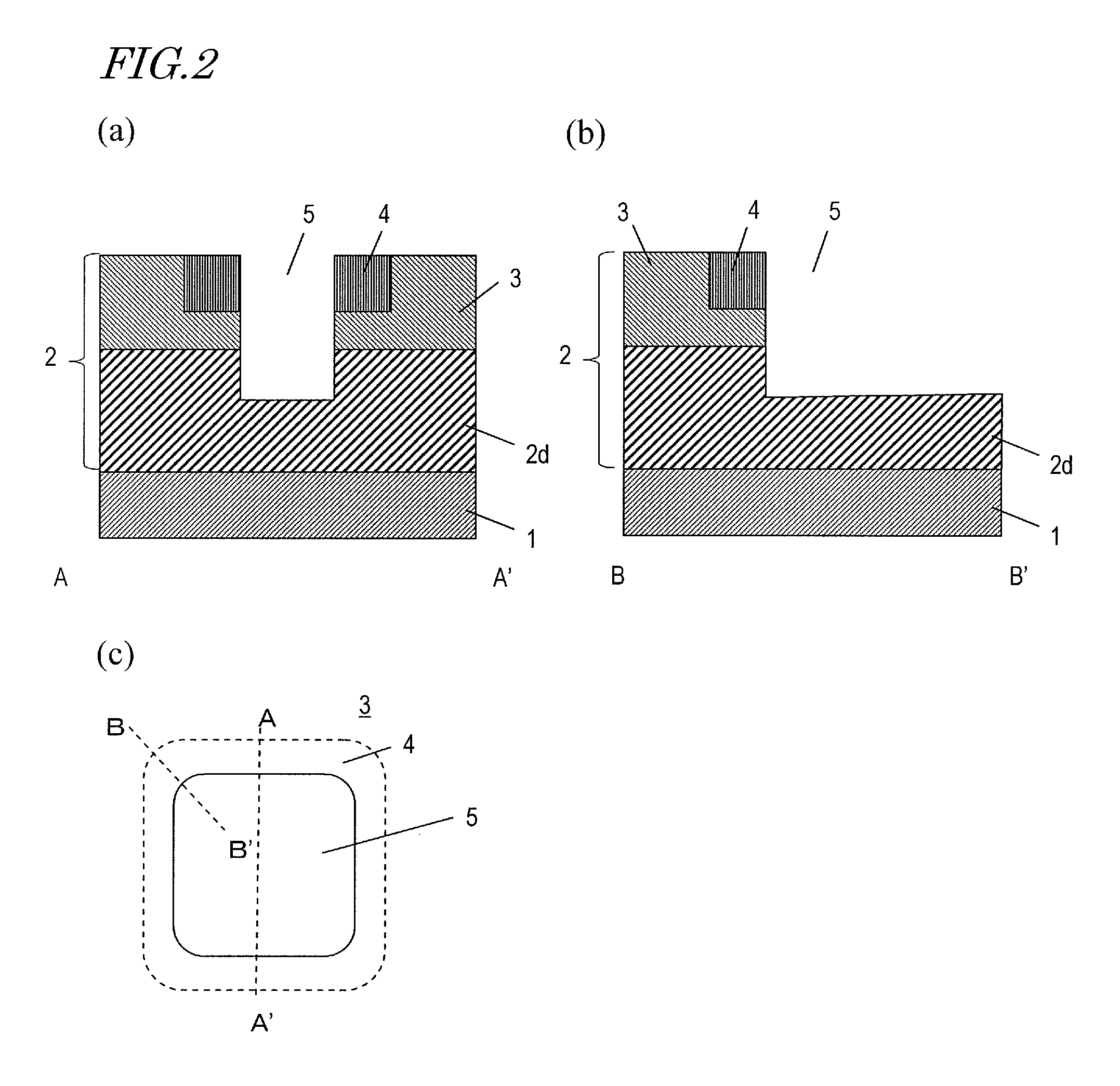Semiconductor device and method for producing same
a semiconductor and gate insulating film technology, applied in the direction of semiconductor devices, electrical devices, transistors, etc., can solve the problem of very high electric field intensity to be applied to gate insulating films, and achieve the effect of preventing dielectric breakdown and reducing electric field intensity
- Summary
- Abstract
- Description
- Claims
- Application Information
AI Technical Summary
Benefits of technology
Problems solved by technology
Method used
Image
Examples
first embodiment
Manufacturing Method of First Embodiment
[0121]Next, referring to the drawings, an example of a method for manufacturing a semiconductor device of the present embodiment will be described.
[0122]FIGS. 2 to 8 are diagrams each illustrating a method for manufacturing a semiconductor device of the present embodiment. In each figure, (a) and (b) are cross-sectional views taken along line A-A′ and line B-B′, respectively, of FIGS. 1(a) and 1(b), and (c) is a plan view of the trench 5. In the present embodiment and embodiments to follow, a portion of the plan view of the trench 5 formed by stripe-shaped cells is omitted.
[0123]First, as shown in FIGS. 2(a) to 2(c), the silicon carbide layer 2 including the drift region 2d of the first conductivity type (herein, n type) and the body region 3 of the second conductivity type (herein, p type) is obtained on the principal surface of the substrate 1, as in a conventional process. Then, the source region 4 is formed in the body region 3. After an a...
second embodiment
Manufacturing Method of Second Embodiment
[0161]Next, referring to the drawings, an example of a method for manufacturing a semiconductor device of the present embodiment will be described.
[0162]FIGS. 10 to 17 are diagrams each illustrating a method for manufacturing a semiconductor device of the present embodiment. In each figure, (a) and (b) are cross-sectional views taken along line A-A′ and line B-B′, respectively, of FIGS. 9(a) and 9(b), and (c) is A plan view of the trench 5.
[0163]First, as shown in FIGS. 10(a) to 10(c), the silicon carbide layer 2 including the drift region 2d of the first conductivity type (herein, n type) and the body region 3 of the second conductivity type (herein, p type) is obtained on the principal surface of the substrate 1, as in a conventional process. Then, the source region 4 is formed in the body region 3. After an annealing treatment is performed to activate the source region 4, the trench 5 is formed in the silicon carbide layer 2. The method fo...
third embodiment
Manufacturing Method of Third Embodiment
[0184]Next, referring to the drawings, an example of a method for manufacturing a semiconductor device of the present embodiment will be described.
[0185]FIGS. 19 to 27 are diagrams each illustrating a method for manufacturing a semiconductor device of the present embodiment. In each figure, (a) and (b) are cross-sectional views taken along line A-A′ and line B-B′, respectively, of FIGS. 18(a) and 18(b), and (c) is a plan view of the trench 5.
[0186]First, as shown in FIGS. 19(a) to 19(c), the silicon carbide layer 2 including the drift region 2d of the first conductivity type (herein, n type) and the body region 3 of the second conductivity type (herein, p type) is obtained on the principal surface of the substrate 1, as in a conventional process. Then, the source region 4 is formed in the body region 3. After an annealing treatment is performed to activate the source region 4, the trench 5 is formed in the silicon carbide layer 2. The method f...
PUM
 Login to View More
Login to View More Abstract
Description
Claims
Application Information
 Login to View More
Login to View More - R&D
- Intellectual Property
- Life Sciences
- Materials
- Tech Scout
- Unparalleled Data Quality
- Higher Quality Content
- 60% Fewer Hallucinations
Browse by: Latest US Patents, China's latest patents, Technical Efficacy Thesaurus, Application Domain, Technology Topic, Popular Technical Reports.
© 2025 PatSnap. All rights reserved.Legal|Privacy policy|Modern Slavery Act Transparency Statement|Sitemap|About US| Contact US: help@patsnap.com



